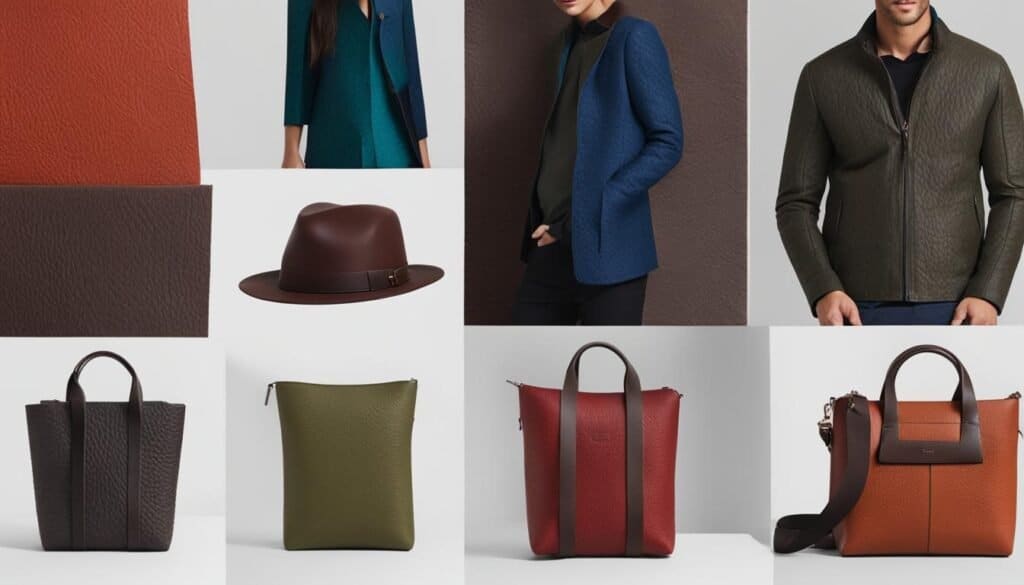As a fashion enthusiast, I’ve always been passionate about keeping up with the latest trends. However, lately, I’ve become more conscious of the importance of sustainable fabrics and ethical practices in the industry. Embracing eco-friendly fashion means not only making sustainable wardrobe choices but also supporting brands that prioritize ethical garment production and use environmentally friendly materials.
From organic cotton to Tencel, there’s a world of eco-friendly fabric options out there for those looking to make more responsible choices. In this article, we’ll explore 35 sustainable textiles that help reduce environmental impact and enable a green clothing revolution. Plus, I’ll introduce some incredible brands and designers leading the way in ethical and sustainable fabrics for eco-friendly fashion.
Key Takeaways
- Discover the world of sustainable fabrics and textiles that support an eco-friendly fashion industry.
- Learn about the environmental impact of various fabrics and choose the right sustainable options for your wardrobe.
- Explore the difference between ethical and non-ethical fabrics and understand why eco-friendly options are increasingly crucial.
- Get to know the brands leading the way in sustainable fashion and ethical garment production.
- Make informed and environmentally responsible decisions when it comes to your fashion choices, and adapt ethical practices in your daily life.
Top 35 Ethical and Sustainable Fabrics
- Organic Cotton: Grown without pesticides and synthetic fertilizers, it has a lower environmental impact than conventional cotton.
- Hemp: A highly sustainable crop that grows quickly, requires little water, and doesn’t need pesticides or herbicides.
- Bamboo: A fast-growing plant that requires no fertilizer and self-regenerates from its own roots.
- Linen (Flax): Made from the flax plant, it is biodegradable, recyclable, and requires less water and pesticides than cotton.
- Recycled Polyester: Made from recycled plastics like PET bottles, reducing plastic waste and environmental footprint.
- Tencel (Lyocell): Produced from sustainably sourced wood pulp, using an environmentally responsible closed-loop process.
- Modal: A type of rayon, made from beech trees, known for its sustainability and lower environmental impact.
- Piñatex: An innovative leather alternative made from pineapple leaf fibers, a byproduct of pineapple harvest.
- Econyl: A regenerated nylon made from recycled materials, including fishing nets and fabric scraps.
- Wool (Ethically Sourced): When sourced responsibly, wool is renewable and biodegradable.
- Organic Silk: Produced without the use of harmful chemicals and in a way that is more humane to silkworms.
- Recycled Wool: Reclaimed from textile waste and used garments, reducing waste and energy consumption.
- Recycled Cotton: Made from post-industrial and post-consumer cotton waste, reducing resource use and pollution.
- Soy Fabric: Made from the byproducts of soybean processing, it’s biodegradable and has a soft, silky feel.
- Peace Silk (Ahimsa Silk): Harvested after the silkworms have naturally left the cocoons, ensuring no harm to them.
- Organic Hemp: Grown without harmful chemicals, it’s durable and has a lower environmental impact.
- SeaCell: Made from seaweed, it’s sustainable, biodegradable, and rich in nutrients beneficial to the skin.
- Qmonos (Spider Silk Protein): A synthetic silk made through microbial fermentation, not involving spiders.
- Banana Fabric: Derived from banana plant stalks, it’s a sustainable alternative to conventional fabrics.
- Recycled Denim: Made from post-consumer waste denim, it reduces waste and conserves resources.
- Fish Leather: Made from fish skins that are byproducts of the fishing industry, offering a unique texture.
- Cork Fabric: Harvested from cork oak trees without cutting them down, it’s renewable and recyclable.
- Coconut Fiber Fabric: Made from the husk of coconuts, it’s a durable and sustainable material.
- Sasawashi: A Japanese fabric made from a blend of washi paper and kumazasa plant fibers, known for its antibacterial properties.
- Organic Ramie: Known for its ability to hold shape and reduce wrinkling, and requires less water and chemicals than cotton.
- Nettle Fabric: Made from stinging nettle plants, it’s durable and grows easily without much water or care.
- Abaca (Manila Hemp): A fiber from the banana family, it’s durable and resistant to saltwater damage.
- Jute: A long, soft, shiny vegetable fiber that can be spun into coarse, strong threads, known for its low water footprint.
- Milk Fabric: Made from casein in milk, it’s biodegradable and has a silky texture.
- Apple Leather: A sustainable material made from apple peel and core waste from the fruit industry.
- Orange Fiber: Made from citrus juice byproducts, offering a sustainable and innovative textile option.
- Mushroom Leather (Mylo): Made from mycelium, the root structure of mushrooms, it’s a sustainable alternative to animal leather.
- Recycled Rubber: Repurposed rubber, often from tires, used in footwear and accessories.
- Kapok: A natural fiber from the seed pods of the kapok tree, it’s lightweight and hypoallergenic.
- Algae Fabric: Made from algae biomass, it’s renewable and can be produced with minimal environmental impact.
The Rise of Eco-Friendly Fabrics in the Fashion Industry

As consumers increasingly demand earth-friendly products, the fashion industry has witnessed an acceleration in green fashion growth. Once considered a niche, eco-friendly clothing is now rapidly escalating its presence in the market. The sustainable clothing industry is ramping up production to provide affordable and stylish alternatives that rival fast fashion, leading to an increasing demand for sustainable materials in the fashion world.
Sustainable Jungle suggests choosing textiles that minimize the impact of their conventional alternatives. This can be achieved through methods like organic and chemical-free farming, using recycled materials, circular manufacturing processes, and sustainable end-of-life disposal.
At the core of the industry’s progression lies the commitment to employing sustainable raw materials and recyclable packaging. Alongside this, sustainable apparel trends include offering resale options through second-hand platforms to promote a circular economy. These efforts are reflective of a broader mission within the industry to diminish waste and carbon emissions, ultimately establishing a sustainable and ethical standard for fashion.
Eco-friendly clothing is transforming the fashion industry as more consumers embrace earth-friendly products and seek out sustainable options.
The fashion industry’s sustainability revolution has paved the way for a myriad of innovative and earth-friendly clothing materials. Some of these game-changers are highlighted below:
- Organic Cotton: A natural fiber grown without harmful chemicals or pesticides, offering a more sustainable option compared to conventional cotton.
- Hemp: A sturdy fiber cultivated with low water usage and minimal pesticides.
- Recycled Polyester: Derived from plastic waste, contributing to the reduction of waste materials destined for landfills and oceans.
- Tencel: A soft, wood-based fiber produced through a closed-loop process with reduced environmental impact.
With a growing interest in fashion industry sustainability, several brands have committed to etching their names in the green fashion growth movement. Notable examples include H&M Conscious, Patagonia, Eileen Fisher, and Kotn, who prioritize ethical practices, fair trade certification, and initiatives like tree planting, and use sustainable raw materials and recyclable packaging for their products.
| Brand | Sustainable Material(s) Used | Key Initiatives |
|---|---|---|
| H&M Conscious | Organic cotton, Tencel, recycled polyester | Fair trade certification, recycling program |
| Patagonia | Organic cotton, hemp, recycled polyester | Carbon emissions reduction, fair wage initiatives, recycling program |
| Eileen Fisher | Organic cotton, Tencel, hemp | Water-saving techniques, chemical-free processes |
| Kotn | Organic Egyptian cotton | Investing in farming communities, no synthetic fertilizers or pesticides |
In conclusion, the rise of eco-friendly fabrics is not merely a passing trend in the fashion industry. It marks a major shift toward promoting earth-friendly clothing and sustainable apparel. By embracing these sustainable materials and practices, the fashion industry continues to work towards a greener and more responsible future, creating a lasting impact on our planet.
Organic Cotton: A Sustainable Staple
Organic cotton has emerged as a frontrunner in the realm of ethical and sustainable fabrics, thanks to its environmentally friendly cultivation practices that require no synthetic pesticides or genetically modified organisms. These farming methods considerably reduce the harm caused to the ecosystem and its inhabitants. Two key factors set organic cotton apart from its traditional counterpart: its superior eco-friendly attributes and the pioneering brands that champion this sustainable staple.
Why Organic Cotton is Superior to Traditional Cotton
The production process of organic cotton significantly lowers its environmental impact. Unlike traditional cotton, organic cotton farming eliminates the use of synthetic pesticides and fertilizers, reducing soil degradation and detrimental effects on nearby wildlife populations. Organic cotton also requires less water during cultivation, conserving a vital resource for the ecosystem. Furthermore, its production methods adhere to international standards for ethical cotton sources, upholding principles of fair labor and sustainable agriculture.
Sustainable Review highlights the benefits of organic cotton. Traditional cotton farming often uses harmful chemicals, but organic cotton avoids most of these, making it a more eco-friendly option.
Organic cotton’s production process not only promotes eco-friendly, sustainable practices but also safeguards the environment and supports fair labor conditions.
Brands Championing Organic Cotton Fabric
Several renowned brands like Kotn and Patagonia have emerged as leaders in the utilization of organic cotton, influencing the fashion industry through their commitment to responsible sourcing and community support. With their innovative approach to using sustainable materials, these brands are paving the way for a greener future in fashion.
- Kotn – This Canadian brand invests in Egyptian cotton farming communities and uses only certified organic cotton in its products. Kotn is dedicated to fostering ethical, sustainable practices within its supply chain, and the brand’s transparent approach to production ensures its commitment to ecological sustainability and social responsibility.
- Patagonia – Patagonia has long been recognized for its comprehensive environmental efforts and mission-driven approach to fashion. The company utilizes 100% organic cotton in its clothing lines, having transitioned from traditional cotton in the 1990s. Furthermore, Patagonia continues to promote sustainable consumption by providing additional avenues for consumers, such as its secondhand collection, Worn Wear.
These brands demonstrate how fashion can seamlessly blend style and ecological responsibility by integrating organic cotton into their product offerings. By choosing organic cotton and supporting brands that champion its use, consumers can actively contribute to a more sustainable, eco-friendly world of fashion.
Hemp Fabric: The Strong and Sturdy Eco-Warrior
Hemp fabric has been gaining popularity in recent years for its remarkable strength and durability, making it a natural eco-warrior in the world of sustainable fibers. This versatile textile is suitable for a wide range of applications, from clothing to accessories and home furnishings, thanks to its sustainability and durability. To better understand why hemp fabric is the ultimate eco-warrior, let’s take a closer look at its key benefits.
Boasting significant ecological benefits, such as low water usage and pesticide-free cultivation, hemp contributes positively to sustainable and ethical fashion practices.
One of the most compelling reasons to use hemp fabric in eco-friendly fashion is its sustainability. Cultivating hemp requires relatively low water consumption and, unlike conventional cotton, it can grow without the need for harmful pesticides or chemicals. This makes hemp an environmentally friendly choice in terms of resource conservation.
| Hemp Fabric | Conventional Fabric |
|---|---|
| Low water usage during cultivation | High water usage during cultivation |
| Pesticide-free | Requires the use of pesticides |
| Biodegradable | Not biodegradable, contributes to waste |
Additionally, hemp fabric is highly durable, making it an ideal choice for long-lasting, high-quality garments. Its strong sustainable fibers contribute to the longevity of the final product, ensuring that clothing and accessories made from hemp will stand the test of time. In fact, hemp fabric is said to be three times stronger than cotton, making it an excellent choice for creating durable fashion items.
Another advantage of using hemp in eco-friendly fashion is its natural resistance to mildew, UV rays, and mold, increasing the lifespan of the garments and accessories made from it. These properties make hemp products particularly well-suited for outdoor wear, offering added protection in demanding environments.
Furthermore, hemp fabric is breathable and hypoallergenic, ensuring that clothes made from it are comfortable to wear and suitable for people with allergies or sensitive skin.
- Low water usage and pesticide-free cultivation
- Strong sustainable fibers for durability
- Mildew, UV, and mold resistance
- Eco-friendly and biodegradable fabric
Hemp fabric offers a wide range of benefits, both ecologically and functionally, making it a strong eco-warrior in the realm of sustainable fashion. Its durability, sustainability, and versatility ensure that hemp fabric remains a popular choice for eco-conscious consumers and fashion brands alike.
Tencel and Modal: The Future of Forest-Friendly Fibers

Tencel and Modal fabrics represent the next generation of forest-friendly fibers, providing sustainable alternatives to traditional textiles. Derived from wood pulp, these fibers are biodegradable and produced with a lower environmental footprint. Moreover, Tencel is celebrated for its production transparency, while Modal is prized for its softness and strength.
Difference Between Tencel and Modal Fabrics
Although both Tencel and Modal originate from wood pulp fibers, there are key differences between the two materials. Primarily, the production process differs: Tencel employs a closed-loop system, utilizing non-toxic solvents and minimal water usage. Modal, on the other hand, requires more water during production but maintains a soft and highly absorbent texture. The table below highlights the different attributes of Tencel and Modal fabrics:
| Attribute | Tencel Fabric | Modal Fabric |
|---|---|---|
| Production Process | Closed-loop system, minimal water usage | Higher water consumption |
| Softness | Soft and smooth | Exceptionally soft and absorbent |
| Strength | Strong and durable | Good strength and durability |
| Biodegradability | Fully biodegradable | Fully biodegradable |
| Environmental Footprint | Lower environmental impact | Slightly higher impact compared to Tencel |
Both fabrics are sought-after choices for sustainable fashion, yet their distinct qualities cater to different needs and preferences.
The Role of Responsibly Managed Forests
Responsibly managed forests play a vital role in the sustainable production of Tencel and Modal fabrics. Practicing forest stewardship helps minimize environmental impact, maintain biodiversity, and ensure the longevity and health of forest ecosystems that serve as the raw material source for these innovative fibers.
When sourcing wood pulp fibers for the production of Tencel and Modal, it is crucial to work with suppliers that prioritize sustainable forestry practices. This includes adhering to standards like the Forest Stewardship Council (FSC) certification, which guarantees the responsible management of forests and supports ethical sourcing initiatives.
By emphasizing the importance of forest conservation in the production of Tencel and Modal fabrics, we can pave the way for a more eco-conscious and sustainable fashion industry that benefits both the environment and consumers.
Bamboo Viscose and its Sustainable Credentials

bamboo viscose has been gaining recognition for its sustainable credentials. It is highly regarded within the industry for its role in the sustainable bamboo production process and its host of benefits for the environment. The reasons for bamboo fabric sustainability are vast, ranging from the plant’s rapid growth to its minimal water and chemical requirements.
One of the key elements contributing to bamboo textile eco-friendly status is its closed-loop production process, which focuses on resource conservation and reducing chemical waste. This process ensures the careful management of water and chemical resources after the viscose fabric is produced. Consequently, it highlights the potential for bamboo viscose to lead the way as a sustainable choice within the fashion realm.
A rising star in the sustainable fabric world, bamboo viscose checks all the boxes when it comes to environmentally friendly materials, paving the way for a greener fashion industry.
When it comes to bamboo fabric sustainability, its unique characteristics further amplify its environmental appeal. To better understand the benefits of bamboo as an eco-friendly textile, let’s delve into the specifics:
- Bamboo’s Rapid Growth Rate: As one of the fastest-growing plants globally, bamboo can quickly replenish itself, making it a renewable and sustainable resource.
- Minimal Water Usage: Bamboo’s low water requirements mean it can be cultivated with significantly less water than conventional crops, helping to conserve this valuable resource.
- Chemical-Free Cultivation: Unlike other crops, bamboo does not require pesticides or other harmful chemicals to grow, minimizing its environmental impact.
With these benefits in mind, it becomes apparent that bamboo viscose is a viable option for those looking to make a positive impact through their wardrobe choices. Its sustainable production paired with the quality and comfort of the fabric solidify its position as an environmentally friendly alternative in eco-conscious fashion.
| Bamboo Viscose | Conventional Viscose |
|---|---|
| Closed-loop production process reduces waste | Open-loop production contributes to environmental pollution and waste |
| Low water requirements for bamboo cultivation | Higher water consumption for conventional viscose production |
| No pesticides or harmful chemicals in bamboo farming | Conventional viscose production often relies on chemical treatments |
| Fast-growing and renewable resource | Other sources may be less sustainable or renewable |
In conclusion, bamboo viscose presents a promising future for the sustainability of fabrics within the fashion industry. Its numerous environmental benefits, coupled with its high-quality production, make it an undeniably appealing choice for those looking for eco-friendly alternatives. By focusing on the sustainable credentials of bamboo viscose and other innovative materials, we can work to create a more environmentally conscious and ethical fashion industry that benefits both our planet and future generations.
Cupro: The Regenerated Cellulose Fiber

For years, the fashion industry has been on a continuous search for eco-friendly fabrics with desirable properties. Enter cupro fabric, a regenerated cellulose fiber obtained from cotton linter, the fibers that coat cotton seeds. Highly underrated and underutilized, cupro has emerged as a game-changer in the world of eco-conscious materials, acing the sustainability factor without compromising on comfort and design.
How Cupro is Changing the Game in the Fashion Industry
The introduction of cupro in the fashion industry marks a significant milestone in sustainable textiles innovation. This biodegradable fabric has caught the attention of fashion enthusiasts and designers alike, thanks to its luxurious, silk-like feel and promising environmental credentials. Perhaps even more impressive is its versatility—it can be woven or knitted into a wide range of fashionable garments, offering up a desirable and ethical alternative to conventional fabrics.
Ecotero introduces soy silk and cork fabric as eco-friendly options. Soy silk is natural and fully biodegradable, using minimal toxic chemicals and dyes, while cork fabric is sustainably made from the bark of cork oak trees.
Derived from cellulosic fibers, cupro not only boasts a lighter environmental footprint but also offers several advantages that set it apart from other sustainable fabrics:
- Its soft, gentle texture makes it an ideal choice for people with sensitive skin
- It possesses excellent moisture-wicking capabilities, providing superior comfort
- Cupro is easily dyed, enabling designers to create vivid colors and patterns
- It can mimic the drape and feel of silk, at a much lower cost
The growing acceptance of eco-friendly cupro as a viable and luxurious alternative to more traditional fabrics is a testament to the heightened awareness and demand for sustainable textiles innovation within the fashion industry. As this trend continues to grow, we can expect to see more and more brands incorporating regenerated cellulose fibers into their collections—a clear indicator of the green shift taking root across the industry.
Indeed, cupro fabric is paving the way for a new era of sustainable fashion, one that not only entertains style and comfort but also embraces environmentally responsible practices. Consumers and designers, now more than ever, have the opportunity to make fashion choices that genuinely make a difference, supporting the global drive towards a greener world.
Recycled Polyester: Turning Plastic Waste into Fashionable Pieces
As the global community becomes more aware of the environmental consequences related to plastic waste, one innovative solution lies in the creation of recycled polyester, a sustainable and eco-friendly fabric solution. This innovative approach not only helps minimize waste, but also affirms the potential for recycling in fashion and textiles, transforming would-be pollutants into valuable resources.
By utilizing discarded plastic materials, such as PET bottles, and converting them into fibers, recycled polyester offers a multitude of advantages over its traditional counterpart. Among these benefits are reduced landfill pollution, diverted ocean plastic waste, and conservation of natural resources, such as water and energy.
Recycled polyester exemplifies the inventive ways in which the fashion industry can help combat the increasing environmental concerns related to waste generation and disposal.
The shift towards integrating recycled polyester in fashion production reflects the growing prominence of sustainable fabric solutions within the industry. Brands big and small have taken notice, increasingly incorporating this eco-friendly polyester into their clothing lines, as well as promoting the broader appeal of upcycled textiles.
- Patagonia – This iconic outdoor brand was among the first to introduce recycled polyester into their product mix, committed to reducing its environmental impact without sacrificing quality or durability.
- Adidas – As part of their commitment to eco-conscious practices, Adidas has developed a line of shoes and clothing utilizing recycled polyester, often in collaboration with Parley for the Oceans, an organization focused on reducing marine plastic pollution.
- Everlane – This ethical fashion brand has introduced ReNew, a collection featuring recycled polyester used to create outerwear, bags, and other accessories.
- H&M – The popular retailer’s Conscious Collection highlights their dedication to making sustainability more accessible, offering various garments crafted from recycled polyester for their environmentally conscious customers.
In addition to contributing towards a greener planet, recycled polyester has a variety of functions and serves various purposes in the world of fashion. With many leading brands incorporating this material into their offerings, recycled polyester continues to gain traction as an eco-friendly textile essential for making our wardrobes more sustainable.
| Apparel Type | Functionality |
|---|---|
| Athletic wear | Due to its moisture-wicking properties and durability, recycled polyester is a popular choice for athletic clothing. |
| Outerwear | The material’s insulating qualities make it ideal for use in jackets, coats, and other cold-weather apparel. |
| Swimwear | Recycled polyester offers excellent resistance to chlorine and salt water, making it an excellent choice for swimwear fabrics. |
| Bags and Accessories | The material’s versatility allows for the creation of eco-friendly bags, footwear, and other accessories with minimal environmental impact. |
In conclusion, recycled polyester is a prime example of innovative problem solving, showcasing how the fashion industry can adopt eco-friendly practices to address environmental concerns and work towards a cleaner Earth. By turning plastic waste into attractive, functional and sustainable garments, recycled polyester continues to inspire fresh approaches to recycling in fashion, promoting further innovation and a brighter, greener future for all.
Animal-Friendly Alternatives: Piñatex and Mushroom Leather

With consumers expressing an increasing interest in sustainable and cruelty-free fashion, innovative textiles such as Piñatex and mushroom leather are gaining momentum as exemplary vegan leather alternatives. Not only are these plant-based materials environmentally responsible, but they also offer a range of benefits, from biodegradability to reduced environmental impact.
Comparing Plant-Based Leathers: Benefits and Challenges
Piñatex, derived from pineapple leaf fibers, has emerged as a sustainable leather substitute with several advantages over traditional leather. Its production process emphasizes a low environmental impact and results in a durable, water-resistant, and biodegradable material. Similarly, mushroom leather, sourced from the mycelium of fungi, is gaining ground due to its soft, suede-like texture and eco-friendly production methods.
Despite their attractive attributes, Piñatex and mushroom leather face challenges, including their scalability and acceptance in the market. Additionally, the durability and aesthetic appeal of plant-based leathers are still being enhanced to fully rival conventional leather options.
| Plant-Based Leather | Benefits | Challenges |
|---|---|---|
| Piñatex | Environmentally friendly, durable, water-resistant, biodegradable | Scalability, market acceptance, improving texture and appearance |
| Mushroom Leather | Suede-like texture, eco-friendly production methods, biodegradable | Scalability, market acceptance, durability enhancements |
How Vegan Leathers Contribute to Sustainable Fashion
As the fashion industry strives to lessen its environmental impact and prioritize ethical considerations, vegan leathers like Piñatex and mushroom leather serve as important contributors to sustainable and cruelty-free fashion. These innovative textiles not only provide stylish and responsible alternatives in the market but also inspire further advancements in the development of animal-friendly materials.
By supporting and promoting the use of plant-based leathers, consumers and businesses alike can foster a more sustainable fashion ecosystem and make a positive impact on our planet’s wellbeing.
Making a Difference with Recycled Nylon: Econyl’s Journey
Amid the recent push towards sustainability in the fashion industry, recycled nylon has emerged as a remarkable and eco-conscious alternative to the more traditional virgin nylon. One standout example of sustainable nylon is Econyl, a material that not only reduces environmental damage but also helps reclaim waste materials, such as discarded fishing nets and fabric scraps.
Through its innovative recycling in textiles process, Econyl is taking the industry by storm, catching the eye of eco-focused consumers and brands alike. More than just a sustainable fabric, this recycled nylon represents the future of the industry, with an emphasis on championing a greener and more responsible approach to textile production.
“We cannot solve our environmental and social challenges by only using natural fibers, we need to invest in synthetics that are recycled, recyclable, and are designed to reduce microfiber pollution.” – Giulio Bonazzi, CEO of Aquafil, the manufacturer of Econyl
Let’s explore the key aspects of Econyl’s journey, unveiling the recycled fabrics difference and highlighting the crucial role that eco-conscious nylon plays in fostering a more ethical and environmentally aware fashion landscape.
- The Recovery Process: Econyl starts with a global cleanup initiative, retrieving abandoned fishing nets and other nylon waste from oceans and landfills.
- Regeneration: The reclaimed waste is transformed into high-quality recycled nylon yarn through a groundbreaking recycling procedure, significantly reducing the material’s eco-footprint.
- Revolutionizing Fashion: Econyl has propelled the adoption of sustainable nylon in garments across the industry, with major brands incorporating the material into their collections. This, in turn, promotes the adoption of recycling practices and furthers the overarching eco-conscious movement in fashion.
As more brands prioritize sustainable materials and processes within their supply chains, Econyl serves as a shining example for those seeking an innovative, eco-friendly, and aesthetically pleasing fabric solution. By leveraging recycled nylon, we champion a greener, more responsible era of synthetic textiles. As part of the broader Econyl journey, it’s increasingly essential that we support sustainable brands and eco-conscious initiatives to drive change from within the fashion industry.
Conclusion on Sustainable Fabric
Understanding the impact of wardrobe choices on the environment and adopting sustainable clothing is essential for promoting ethical fashion. By becoming an informed consumer and selecting garments made from eco-friendly materials and fair labor conditions, you can significantly reduce your ecological footprint and contribute to positive changes in the industry.
Discovering sustainable fabrics for your clothing line entails connecting with suppliers and manufacturers committed to green practices. Networks like Fashinza offer access to a wide array of trusted sources for eco-friendly materials that cater to the needs of conscientious brands, helping to create a more sustainable and ethical fashion industry.
Committing to ethical practices in everyday fashion means embracing sustainability not just as a trend but as a lifestyle. Prioritize supporting brands that uphold fair trade initiatives, use recycled materials, and implement environmentally conscious manufacturing processes. By making deliberate choices and adopting eco-friendly habits, you can help pave the way to a more sustainable future for fashion.
FAQ on Ethical and Sustainable Fabrics for Eco-Friendly Fashion
Q: What exactly is a sustainable or eco-friendly textile?
A: A sustainable or eco-friendly textile also known as ethical fabric, adheres to a variety of environmental and social standards including reduced energy and water use, minimized greenhouse gas emissions, the promotion of biodiversity, and fair wages for workers.Fabrics like linen and lyocell fabric from sustainably managed resources are typical examples. These fabrics also often bring certification such as the global organic textile standard (gots) to validate their sustainability.
Q: How can I buy sustainable and ethical fabrics for my fashion business?
A: You can buy sustainable and ethical fabrics from various online fabric sources and eco fabric suppliers committed to sustainable production and fair trade practices. Always look for certification such as GOTS to ensure that the fabric is genuinely sustainable.
Q: What are some common sustainable fabrics on the market today?
A: Some of the most common sustainable fabrics on the market today include organic fabric like linen, deadstock fabric, and lyocell fabric which are all made in a way that impacts the environment less negatively than conventional methods.
Q: What are some best sustainable fabric options if I am allergic to linen?
A: If you are allergic to linen, a fabric made from flax, some of the best sustainable fabric options for you could be organic cotton, bamboo, or Tencel fabric. These are all soft, hypoallergenic, and produced sustainably.
Q: How do I find sustainable fabric suppliers for my new fashion line?
A: To find sustainable fabric suppliers, you could start by doing an online search for suppliers and then checking their sustainability credentials. You can also look for certifications such as GOTS or simply call the supplier and discuss their approach to sustainable sourcing.
Q: What is deadstock fabric and how does it contribute to sustainable fashion?
A: Deadstock fabric is fabric that was overproduced or unwanted by other fashion brands and would otherwise end up as waste. By utilizing deadstock fabric, designers can create new pieces without the use of new resources, contributing to a reduction in overall textile waste and making it a sustainable choice.
Q: Could synthetic fabrics be made sustainably?
A: Yes, some synthetic fabrics can be made sustainably. For example, recycled nylon fabric and polyester made from plastic bottles provide a sustainable alternative to conventional synthetic materials that are derived from non-renewable petroleum.
Q: Are there fabric options that can be sustainably and ethically sourced and also good for garments?
A: Yes, there are many fabric options that are both good for garments and can be sourced sustainably and ethically. For instance, organic cotton is soft, durable, breathable, and can be produced in a way that is kinder to the environment and workers. Similarly, linen and Tencel are both sustainable and offer unique textures and drapes that work well for certain types of garments.
Q: What is the role of fabric suppliers in promoting sustainable and ethical fabric?
A: Fabric suppliers play a crucial role in promoting sustainable and ethical fabric by choosing sustainable fabrics to stock, working to ensure fair labor practices in their supply chains, and helping to educate customers about the benefits of choosing sustainable fabrics.
Q: Can you give me a list of sustainable and ethical fabric sources?
A: Many fabric suppliers are committed to sustainable sourcing. A few examples include Organic Textiles, Harmony Art, O Eco Textiles, and Pickering International. You can also buy deadstock fabric from suppliers like FabScrap and Queen of Raw. Always do your due diligence to make sure the supplier’s sustainability claims are backed by credible certification or third-party audits.





Leave a Reply